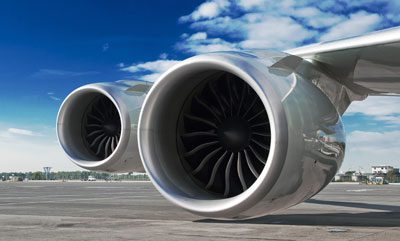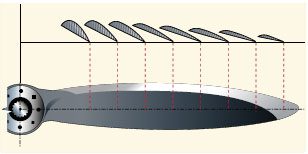The aircraft’s engine or propeller, often known as the power plant of an aircraft works in combination to produce thrust. The power plant propels the craft and drives various system that support the operation of an aircraft
Reciprocating engines
Most of the small planes are designed with reciprocating engines. The meaning of it derived from the back-and-fourth, or reciprocating, movement of the pistons this motion produces the mechanical energy needed to accomplish work. Two means of differentiating reciprocating engines are:
- By cylinder process respect to crankshaft-radial, in line, v-type or opposed, or
- By cooling-liquid method
Radial engines were widely used during the age of World War II, and many are still in service at present.
A V-type engine gives more horsepower than in-line engines and still continues to have a small frontal area.
The main parts of reciprocating engine include the cylinders, crankcase, and accessory housing. The crankshaft and connecting rods are placed in the crankcase. Magnetos are normally located on engine accessory housing.
Fig 1: Main components of a reciprocating engine.(Photo;aero-mechanic
The basic principle for reciprocating engines involves conversion of chemical energy in form of fuel, into mechanical energy. This occurs inside the cylinders of the engine through a process known as four-stroke operation cycle.
- Intake stroke begins as the piston starts downward travel. When this happens, the intake valve opens and the fuel/air mixer is drawn into the cylinders.
- Compression stroke begins as the piston starts its downward travel, when this happens the intake valve opens and the fuel mixture is drawn into cylinder.
- The power stroke begins when the air mixture is ignited. This causes a tremendous pressure increases in the cylinder, force piston downward away from the cylinder of burned gases. This begins when exhaust valve opens and the piston starts to move toward the cylinder once again
Even when engine is operated at fairly low speed, the four-stroke cycle takes place many hundred times each minute. In four-cylinder engine, each cylinder operates on a different stroke. Continuous rotation of crankshaft is maintained by precise timing of the power strokes in each cylinder.
Propeller
The propeller is a spinning/rotating airfoil subject to induce drag and stalls. It provides necessary thrust to pull, or in some cases push, the airplane through the air.
The engine power is used to rotate propeller which generate thrust very similar to the manner in which a wing produce lift.
Changing the angle of incidence (pitch) from hub to tip of the correspond with the speed produces uniform lift throughout the length of the blade. If the propeller blade was designed with saneangle throughout its entire length.
Fixed-pith propeller
Pitch of this propeller is set by manufacturer, and cannot be changed. With this kind of propeller the best efficiency is achieved only at a given combination of airspeed and r.p.m. There are two types of fixed-pitch propellers-the climb propeller and the cruise propeller. Whether the airplane has a climb or cruise prop fitted depends upon its intended use on of them is
- Climb prop has a lower pitch, therefore less drag. Less drag results in high r .p .m and more horsepower capability which will increase its performance during takeoff but decreases during cruising.
Adjustable-pitch propeller
Although some older adjustable- pitch propellers could be adjusted on the ground, most modern propellers are made so that you can change the propeller pitch in flight.
Induction system
Induction system brings in air from outside, mixes it with the fuel, and delivers the fuel mixture to the cylinder where the combustion occurs.
Two types of induction system are commonly used in small craft engines:
- The carburetor system, which mixes the fuel in the carburetor before mixture enters the intake manifold
- The fuel injection system, which mixes the fuel and air just before entry into each cylinder.
Carburetor system
Carburetors are classified as either float type or pressure type. The basic difference between pressure carburetor and a float type is the pressure carburetor delivers fuel under pressure by the fuel pump.
Mixture control
Carburetors are normally calibrated at sea-level pressure, where the correct fuel-to-air mixture ratio is established with the mixture control set in the full rich position. However, as altitude increases, the density of air entering carburetor density of air entering the carburetor decreases. This creates a progressively richer mixture.
Outside air temperature gauge
Most of the airplanes are equipped with an outside air temperature ( OAT ) gauge calibrated in both degrees Celsius and Fahrenheit. It provides outside air temperature for calculating true airspeed, and also is useful detecting icing conditions.
Fuel injection systems
In a fuel injection system, the fuel is injected by directly into the cylinders, or just ahead of the intake valve. A fuel injection system is considered to be less susceptible to icing than carburetor system.
Advantages of fuel injection:
- Reduces evaporating icing.
- Better fuel flow
- Better fuel distribution
- Fast throttle response
- Easier cold weather starting
- Precise ontrol of mixture
Disadvantages are:
- Difficulty starting hot engines.
- Vapor locks during ground operations on hot days.
- Problems associated with restarting an engine that quits because of fuel starvation.
Turbo supercharges
The most efficient method of increasing horsepower in reciprocating engine is by use of turbocharger. The advantage of turbochargers is that they can be controlled to maintain an engine’s rated sea-level horsepower up to the engine’s critical altitude.
High altitude performance
As an aircraft equipped with turbo charging system climbs, the waste gate is gradually closed to maintain the maximum manifold pressure. Critical altitude is established by the airplane manufacturer. When evaluating the performance of turbo charging system the engine and turbo charging system should be inspected by a qualified aviation maintenance technician to verify the system’s proper operation.
Ignition system
Ignition system provides the spark that ignites the fuel/air mixture in the cylinders and is made up of magnetos, spark plugs, high-tension lead, and ignition switch.
A magneto uses a permanent magnet to generate an electric current fully independent of the craft’s electric system.
The operation of magneto is controlled in cockpit by ignition switch. The switch has 5 positions.
- OFF
- R-Right
- L-left
- Start
- Both
Fuel combination
Of accidents attributed to power plant failure contamination most have been traced to:
- Lack of proper maintenance
- Storing aircraft with partially filled fuel tanks
- Preflight inspection by the pilot
Refueling procedures
Static electricity is formed by friction of air passing over surface of an aircraft while flying and by flow of fuel through hose and nozzle during refueling.
Drums should be placed near grounding post, and the following sequence of connections observed:
- Drum to ground
- Drum to aircraft
- Ground to aircrafts
- Nozzle to aircraft before fuel cap is removed
Starting system
Most small crafts use a direct-cranking electric starter system. It consists of a source of electricity, Wiring, switches, and solenoids to operate a starter motor.
Engine cooling systems
The burning fuel within the cylinder produces intense heating. Much of the remaining heat, however, must be removed or dissipated to prevent the engine from overheating.
The air cooling is less effective during ground operations, takeoffs, go-around and other periods of high-power, low-airspeed operation.
Under normal operating conditions in aircraft not equipped with cowl flaps, the engine temperatures can be controlled by changing the airspeed or the power output of the engine.
Exhaust systems
Engine exhaust systems vent the burned combustion gases overboard provides heat to the cabin and the wind screen.
For cabin heat outside air is drawn into the air inlet and is ducted through a shroud around the muffler.
Exhaust gases contain large amounts of carbon monoxide, which is odorless and colorless. Carbon monoxide is deadly and it is impossible to detect
Some exhaust systems have an exhaust gas temperature probe which transmits the exhaust gas temperature to an instrument in the cockpit.
Photo By: online private pilot ground School








